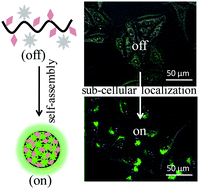当前位置:
X-MOL 学术
›
New J. Chem.
›
论文详情
Our official English website, www.x-mol.net, welcomes your feedback! (Note: you will need to create a separate account there.)
Functionalized chitosan with self-assembly induced and subcellular localization-dependent fluorescence ‘switch on’ property†
New Journal of Chemistry ( IF 3.3 ) Pub Date : 2018-03-07 00:00:00 , DOI: 10.1039/c8nj00067k Kuheli Mandal 1, 2, 3, 4 , Debabrata Jana 4, 5, 6, 7 , Binay K. Ghorai 4, 5, 6, 7 , Nikhil R. Jana 1, 2, 3, 4
New Journal of Chemistry ( IF 3.3 ) Pub Date : 2018-03-07 00:00:00 , DOI: 10.1039/c8nj00067k Kuheli Mandal 1, 2, 3, 4 , Debabrata Jana 4, 5, 6, 7 , Binay K. Ghorai 4, 5, 6, 7 , Nikhil R. Jana 1, 2, 3, 4
Affiliation

|
Chitosan-based polymers are commonly used as drug delivery carriers and for functional modification of nanoparticle/polymers. Herein, we report a functional chitosan oligosaccharide with a self-assembly-induced fluorescence ‘switch on’ property, and that also exhibits a similar type fluorescence ‘off’ to ‘on’ state via subcellular localization. Specifically, chitosan oligosaccharide was conjugated with aggregation induced emission (AIE) active tetraphenylethene (TPE) and lipophilic–cationic triphenylphosphonium (TPP) molecules. The resultant functional chitosan self-assembles into 50–200 nm particles, whereby TPE offers a self-assembly induced fluorescence ‘switch on’ property and TPP offers cell uptake via lipophilic–cationic surface properties. The self-assembled chitosan nanoparticle enters into the cell predominately by lipid-raft endocytosis and exhibit a fluorescence ‘off’ to ‘on’ state upon localization at the lysozome. We have shown that adjustment of the number of TPP/TPE molecules bound to each chitosan is critical for the self-assembly induced fluorescence ‘switch on’ property and the subcellular localization-dependent fluorescence ‘off’ to ‘on’ state performance. Other fluorescence ‘switch on’ type sub-cellular imaging probe could be designed with appropriate functional modification of chitosan oligosaccharide or similar macromolecules.
中文翻译:

具有自组装诱导和亚细胞定位依赖性荧光“开启”特性的功能化壳聚糖†
基于壳聚糖的聚合物通常用作药物递送载体并用于纳米颗粒/聚合物的功能改性。在这里,我们报告功能壳聚糖寡糖具有自组装诱导的荧光“打开”属性,并且还表现出类似的类型的荧光“关闭”到“打开”状态,通过亚细胞定位。具体而言,壳聚糖寡糖与聚集诱导发射(AIE)活性四苯乙烯(TPE)和亲脂性阳离子三苯基phosph(TPP)分子缀合。产生的功能性壳聚糖自组装成50-200 nm的颗粒,从而TPE提供了自组装诱导的荧光“开启”特性,而TPP通过以下途径吸收了细胞亲脂阳离子表面性质。自组装的壳聚糖纳米颗粒主要通过脂质筏内吞作用进入细胞,并在溶菌酶定位后显示荧光“关闭”至“开启”状态。我们已经表明,调节与每个壳聚糖结合的TPP / TPE分子的数量对于自组装诱导的荧光“开启”特性和亚细胞定位相关的荧光“关闭”至“开启”状态性能至关重要。可以设计具有壳聚糖寡糖或类似大分子的适当功能修饰的其他荧光“开启”型亚细胞成像探针。
更新日期:2018-03-07
中文翻译:

具有自组装诱导和亚细胞定位依赖性荧光“开启”特性的功能化壳聚糖†
基于壳聚糖的聚合物通常用作药物递送载体并用于纳米颗粒/聚合物的功能改性。在这里,我们报告功能壳聚糖寡糖具有自组装诱导的荧光“打开”属性,并且还表现出类似的类型的荧光“关闭”到“打开”状态,通过亚细胞定位。具体而言,壳聚糖寡糖与聚集诱导发射(AIE)活性四苯乙烯(TPE)和亲脂性阳离子三苯基phosph(TPP)分子缀合。产生的功能性壳聚糖自组装成50-200 nm的颗粒,从而TPE提供了自组装诱导的荧光“开启”特性,而TPP通过以下途径吸收了细胞亲脂阳离子表面性质。自组装的壳聚糖纳米颗粒主要通过脂质筏内吞作用进入细胞,并在溶菌酶定位后显示荧光“关闭”至“开启”状态。我们已经表明,调节与每个壳聚糖结合的TPP / TPE分子的数量对于自组装诱导的荧光“开启”特性和亚细胞定位相关的荧光“关闭”至“开启”状态性能至关重要。可以设计具有壳聚糖寡糖或类似大分子的适当功能修饰的其他荧光“开启”型亚细胞成像探针。



























 京公网安备 11010802027423号
京公网安备 11010802027423号